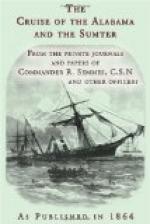Thursday, November 14th.—Rain in the forenoon. Busy coaling, and getting on board a few necessary stores. It is reported that the Iroquois sailed from Trinidad on the 2nd November, and that there are three ships of war of the enemy at St. Thomas’, one sail vessel, and two steamers; and that one of these was expected here last night. She has not yet made her appearance. It will be difficult for her to prevent our sailing. At 2.30 P.M. the steam-sloop Iroquois of the enemy made her appearance, coming round the north end of the island. She had at first Danish colours flying, but soon changed them for her own. She steamed ahead of us very slowly, and, taking up a position some half to three-quarters of a mile from us, stood off and on during the afternoon and night. Finished receiving our coal and provisions (sugar and rum) at about 9 P.M., when I permitted the crew to have their hammocks as usual. Directed everything to be kept ready for action. Visited in the afternoon by the mayor of the city and some gentlemen, who assured me of the sympathy of the citizens, and of the colony generally. At 1.30 A.M. I was called by the officer of the deck, and informed that the Iroquois was standing in for us, and approaching us very close. Called all hands to quarters, and made all preparations to receive the enemy in case he should attempt to run us on board. He sheered off, however, when he came within three or four hundred yards. He repeated this operation several times during the mid-watch, imposing upon us as often the necessity of calling the men to quarters; indeed, from about half-past two they slept at their guns. Great excitement pervades the entire city. The market-square, the quays, and the windows of the houses, are thronged by an eager and curious multitude, expecting every moment to see a combat. The enemy approached us at one time within a ship’s length.
Friday, November 15th.—Fine, bright morning. At 7.30 a French steamer of war, L’Acheron, Captain Duchaxel, came in from Fort de France, and made fast to one of the buoys. The Iroquois about a mile from us. At 8.30 sent a boat on board the Frenchman to pay the usual ceremonial visit. The throng in the town unabated, multitudes being gathered near the water, looking out at the two ships. At 10 the French captain paid me a visit. He came up, he said, with orders from the Governor, to preserve the neutrality of the port between the two belligerents, and in case the Iroquois came to an anchor, to demand of the captain a promise that he would not proceed to sea for twenty-four hours after our own departure. I wrote to the Governor, informing him of the violation of the neutrality of the port by the Iroquois, and desiring him to apply the proper remedy:—
C.S. steamer Sumter, St. Pierre, Island of Martinique, November 15th, 1861.




